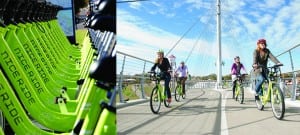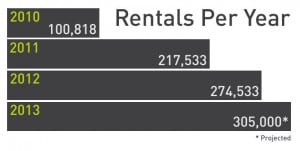Urban bike share initiatives may seem like old hat now, as such programs have cropped up in a slew of American cities in recent years. However, in 2010 many Americans had no idea what a bike-share program was. The only existing program at the time was Denver’s B-Cycle. Paris and a few other international locations were also leading the two-wheeled way.
So when Minneapolis decided to launch a bike-share program city officials knew that it would take a lot of citizen education at the front end and a sustained effort on the backend to get the program running smoothly.
Roepke Public Relations (RPR) got involved when one of its clients, Duffy & Partners, designed Minnesota Nice Ride’s logo. RPR agreed to write the messaging and pitches on that story, pro bono, for the launch.
The project debuted in 2010, and is now considered a model for other programs across the United States, a trend that Roepke makes sure to point out to publications around the world when they’re covering Minnesota.
GEAR UP
“We started Nice Ride to make biking mainstream in the Twin Cities,” said Bill Dossett, executive director of Nice Ride. “With Roepke’s PR support and its relationships with national journalists, our experience became a national model for bike-sharing,” he added. “This national attention has been terrific for the active living movement and our ability to attract sponsors and partners, essential to the nonprofit model.” One of the key elements of the program prior to launch was creating messaging that explained bike share and instilled community pride in the locally owned program. Blue Cross Blue Shield of Minnesota was one of the early investors.
“We made the connection between active transportation and health,” said Katherine Roepke, president of RPR, who is also a board member of Nice Ride.
She added, “Minnesotans recognized the Blue Cross Blue Shield of Minnesota investment as a logical path towards a healthier community. Nice Ride captured curiosity; Will it succeed? Will it fail? Is it sustainable?”
Those types of questions helped bring people together and invest emotionally in the program. One thing Roepke did well early on, Dossett said, is cut off any coverage suggesting that Nice Ride was a program against cars. “Roepke didn’t let that happen,” he said. The agency “understood that bike sharing is about creating easy choices for people who want healthier lifestyles, and helped us tell that story from day one.”

RECYCLING
Nice Ride kicked off in June 2010, with 65 stations and 700 bikes available. The city threw a “Bike Walk to Work Day,” inviting people to join an inaugural bike ride down Nicollet Mall, a pedestrian and transit mall running through downtown Minneapolis.
After the ride, Minneapolis Mayor R.T. Rybak hosted a ribbon-cutting ceremony in front of the downtown YWCA Nice Ride station, as well as a press conference, along with other local politicians and the program’s sponsors.
“Our messaging had to be enthusiastically clear and concise; explaining the benefits of a bike share system and also drilling down to the basics, such as subscriptions versus 24-hour passes,” Roepke said.
To help spread the word, Roepke invited local journalists to take a ride. The agency handled everything in order to ensure the reporters had a positive experience.
This resulted in coverage on all local TV stations as well as regional dailies, weeklies and monthlies, such as Minnesota Monthly, the Pioneer Press and Twin Cities Business, among others. The AP also ran a positive story that got international pickup.

A NEW SPIN
Because bike sharing was so new, the agency was prepared for negative press from those who didn’t understand it. “There was a learning curve and with learning curves comes frustration,” Roepke said. “We were prepared and immediately addressed every grumble. [Dossett] was tirelessly available at any hour to speak with the press.”
She stressed that it was crucial that the agency be able to respond immediately to any negative press about the program.
“Be strategically transparent and allow journalists to tell the public that you are listening; you understand and are actively working on solutions,” she said. “It sounds rudimentary, but people mistakenly think that if they don’t talk about it, misconceptions will go away. With this tactic, we avoided or counteracted the undesirable press that other bike share systems have faced.”
THE RESULTS
Nice Ride now has 170 stations and 1,500 bikes. It has served up more than 300,000 trips and is often used as a model for public bike share programs across America. “Nice Ride was the first to develop a nonprofit, public-private partnership model for bike sharing,” Dossett wrote in his 2011 annual report.” The program has expanded to include St. Paul and is exploring expansion into the rest of the state.
Nice Ride also garnered the following coverage:
• Men’s Journal named Minneapolis/St. Paul one of the five best cities to live, largely focusing on Nice Ride.
• Travel + Leisure featured Minneapolis as a bike-friendly metropolis and mentioned Nice Ride.
• National Geographic included Nice Ride in its “10 Best Trips of Summer.”
• The League of American Bicyclists gave Minneapolis one of its highest rankings for being a bike-friendly city.
• Minneapolis was listed as one of America’s top biking cities in media outlets such as Huffington Post, Outside and Shermans Travel.
Nice Ride also helped the city get coverage across the globe in stories related to travel, transportation alternatives, and health, among other things.
“Nationally, we pitch and facilitate interviews with media in cities exploring bike share systems,” Roepke said, adding that the campaign pitches “cities that have incorporated bike share systems; graduate and undergraduate students writing papers; and anyone writing about improving urban areas, active lifestyles, environment and transportation.”
Locally, though, it’s all about encouraging people to use bikes more frequently.
“Many cities want what Minneapolis has: a reputation for being biker-friendly,” Dossett said.
The goal, he stressed, is to help inspire other cities—big and small—to follow suit.
“We need to find the right partners and develop the right tools to make riding a bike an easy choice in small towns,” he said. “More importantly, we need to bring communities together so that everyone will see investment in cycling infrastructure as a smart choice for their city and their economy.”
In less than three years, Nice Ride has been able to do that for America’s 48th largest city and help put Minneapolis in the same breath as Paris, Barcelona and Buenos Aires. PRN
CONTACT:
Bill Dossett, @NiceRideMN; Katherine Roepke, [email protected].
3 Tips on Turning a Regional Story into a National Story
All good public relations professionals know that you must understand each journalist’s audience, demographic, beat and style. This is particularly the case when you’re trying to take a local story and nationalize it. The following tips are designed to help expand your story’s appeal and the number of journalists who may be interested in the subject matter.
1. Broaden your story ideas. Don’t limit your pitching to features on your client. Get your team together and brainstorm relevant topics and story ideas. This will allow you to pitch multiple story ideas to continually keep your client included in broader stories, spanning multiple targets and media outlets.
2. Create separate media lists for each topic or story idea. Create and maintain a media list for each topic, which necessitates that you have numerous, separate media lists for each client. In addition to the database, we research the journalist and include notes on his or her writing styles and recent articles. We also search editorial calendars for each topic and include appropriate journalists based on relevant calendar items. Our team keeps active media lists updated via researching current news.
3. Craft a different pitch for each journalist. Messaging for editorial coverage must be clear and objective. It must also remain consistent. While each pitch is different, we strategically craft messaging that is integrated to our client’s objectives and mission. We recommend developing style guides so that all PR messaging is consistent. This establishes organization language that unifies messaging for all stakeholders, including the various media outlets.
Katherine Roepke is president of Roepke Public Relations.
This article originally ran in the December 23 issue of PR News.
